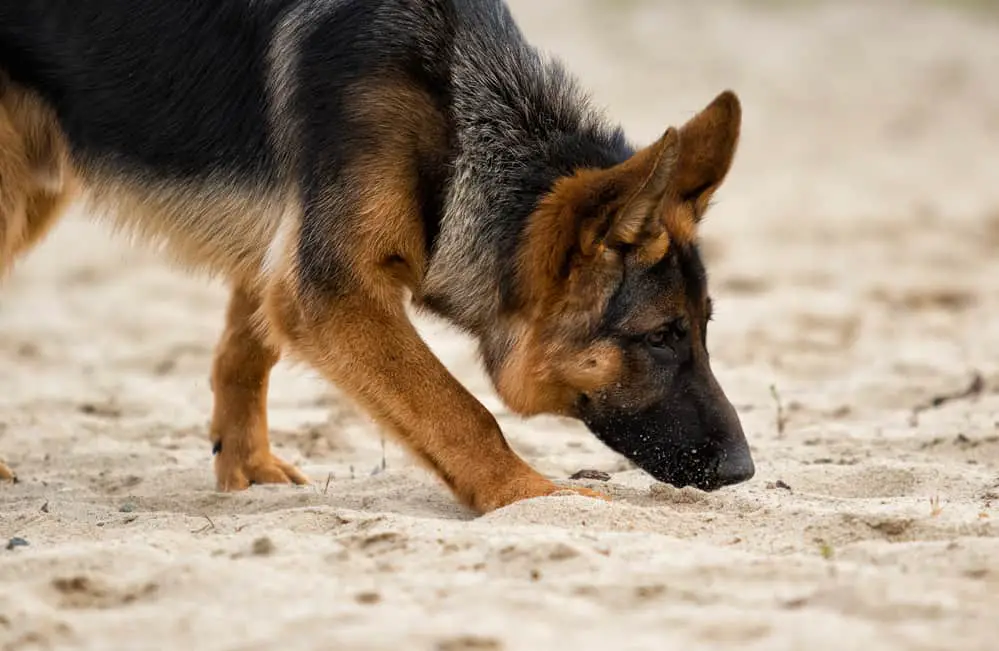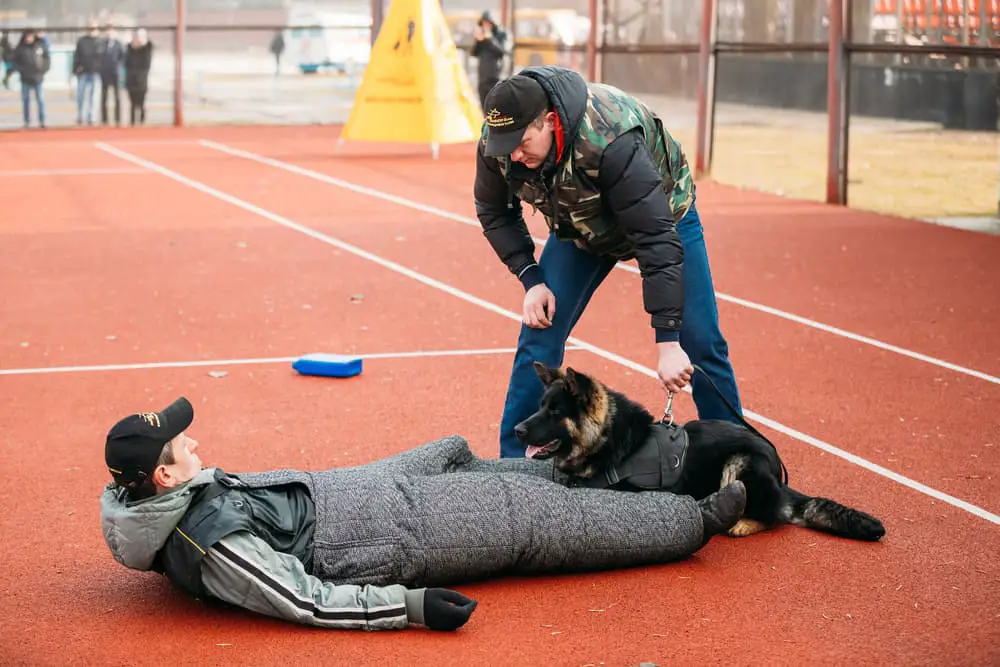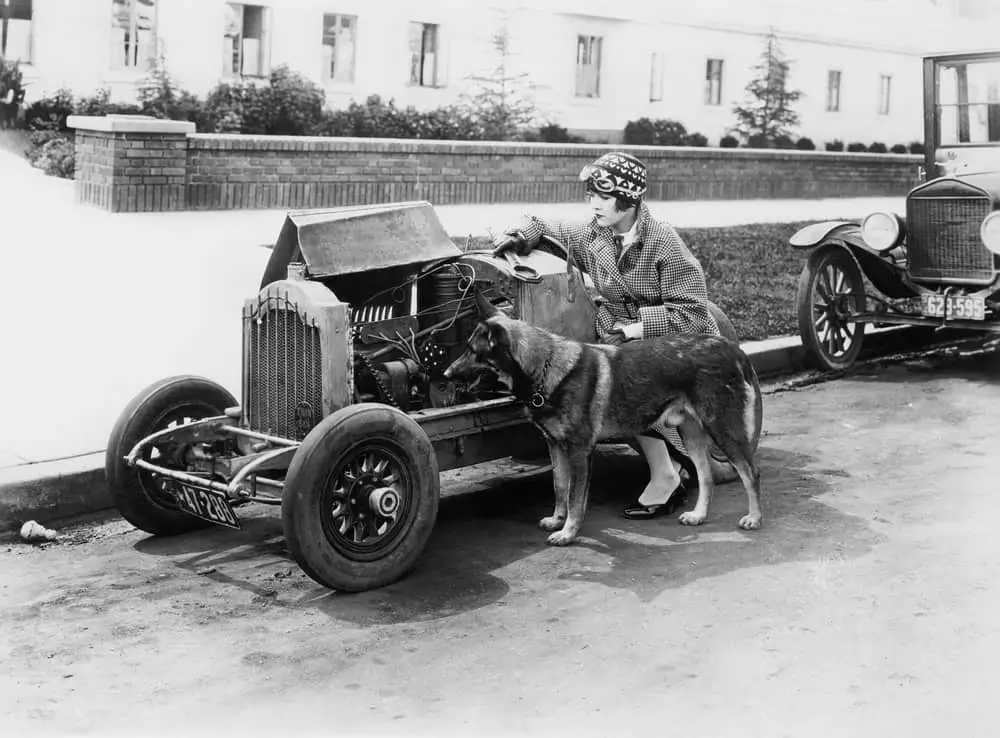We’ve all seen them in the news, on TV shows, in movies, and sometimes in person.
German Shepherds are the most common breed used by Law Enforcement.
But why are German Shepherds used as police dogs rather than other breeds?
Sense of Smell

Well, there are a host of other breeds that are used for different areas of law enforcement.
You’ve got some breeds that excel in the sniffing department, used to find missing people, manhunts, riot dogs, or to search for drugs at border crossings and airports.
Often Bloodhounds, Beagles, Labrador Retrievers, and German Shorthaired Pointers, all are well known and highly regarded for their effective sense of smell, and are often used for that specific purpose.
Takedowns

Other breeds are used for their well-earned menacing reputation to be able to take down bad guys.
These are either dogs large enough to knock someone off of their feet by way of latching on and throwing their weight around or are powerful enough to grab a leg and hold on to it till its trainer catches up.
Breeds often used for these purposes are Rottweilers, the Giant Schnauzer, Doberman Pinschers, the Belgian Malinois, and now, police are taking in and training rescued Pit Bull Terriers in some parts of the United States, as on-duty police dogs.
As these dogs are used for their strengths, there’s one dog that has proven itself to be the most versatile of the bunch. That breed of K9 would be the German Shepherd.
[ Read Our Belgian Malinois vs German Shepherd Comparison Here ]A History of Service

Ever since the 1890s, when the German Shepherd was first recognized as its own breed, the characteristics valued about the dog was its utility and intelligence, as per the German Shepherd Dog Club of America.
As their name denotes, their first mission as a working-class dog was to shepherd livestock out in the fields.
Because this breed had no problem proving its intelligence early on in its history, it didn’t take anyone long to recognize the value that these dogs could provide.
These loyal Shepherds were recruited to serve in both world wars, proving their worth in saving and protecting lives in one way or the other.
In those days, they were most often used as messenger dogs, sentries, Red Cross dogs, ammunition carriers, search and rescue, and also guard dogs.

By 1944, a list of breeds had shrunk down to seven dogs that the military found were the most versatile, and the best fit for the tasks required from their K9 units.
That list of breeds was: German Shepherds, Belgian Sheepdogs, Eskimo Dogs, Collies, Siberian Huskies, Malamutes, and Doberman Pinschers.
Of all the duties assigned to each K9 unit, it was the German Shepherd that proved to be the most versatile.
There was a German Shepherd that was brought home from the war and found stardom in silent films- His name was Rin Tin Tin.
The Working Dog

German Shepherds have been bred for over 100 years to be working dogs. They need to be doing something in order to maintain a level of good behavior.
Those who are lucky enough to be picked for service, they’ve been matched with the perfect stimulant as well as a means to burn off some energy.
- They are intelligent, which makes them easier to train.
- They are loyal, which helps them to obey commands.
- They focus on what they’re trained to stay focused on, which makes them a better choice when in situations where concentration amidst the chaos is required.
- They have the drive to complete tasks that they start.
- Their sense of smell has proven the GSDs (German Shepherd Dogs) to be effective in sniffing out drugs, explosives, etc…
- German Shepherds commit themselves to guard and protect their handlers as alpha’s of a pack would protect their pack.
- They have a high sense of incoming aggression, which makes them active in determining whether or not someone is either being or about to be aggressive- and acting on it.
- They have the size, the strength, the weight, and the stamina, to take down bad guys when the need arises.
- Being highly energetic dogs, they delight in working and working and working.
How Much are Police Dogs?

A good police K9 can cost a city or town anywhere between $8,000 to $15,000, according to the Journal News.
Though this might sound steep for a dog- even a trained dog, money used to purchase a dog trained for the Police Force is often rallied through donations or money from drug-related seizures, if not provided through an appropriation of funds vote in a city council.
Also, though it sounds like a steep expense (you can also throw food in with an overall expense for the dog), bear in mind that the dog is an active member of the police force, who works for fun, food, and the love of its handler. In the world of finance, this is a fairly cheap employee.
And the willingness of a police dog to do its job and protect its fellow officers often results in the wounding or death of the dog when cut-loose against an armed criminal.

Often, this results in either saving the life of a fellow officer or at the least removing the element of surprise.
There are good reasons why an entire police station will mourn the loss of a K9 unit. Often it isn’t just limited to the station, but reported on the news, and when the circumstances reach a certain level of heroism, the news will spread either statewide or nationwide.
When placed into its proper context rather than the “it’s just a dog” mentality, 8-15 thousand dollars doesn’t sound like that much money anymore in the face of self-sacrifice and saving lives.
Track – Attack – Detect

There are three fields of service that German Shepherds (among other breeds of police dog) are trained to perform.
- Track– This is using the nose and its other heightened senses to either find a person (living or corpse) who may be fleeing a scene, lost, buried or trapped, or a missing person.
- Attack– This is fairly self-explanatory. This is stopping a perpetrator in his tracks by latching on and taking him down until the handler catches up to call it off. Holding and releasing are both crucial elements of a K9’s training. There have been lawsuits that have been rewarded to some who were severely injured by police K9s who refused to obey commands to cease. So this step is particularly important to practice till it’s like clockwork.
- Detect– This is where the German Shepherd is trained to sniff out items that have been deeply hidden. This is done for the purposes of finding explosive materials, drugs/paraphernalia, electronics, blood, or other types of fluids.
Before any form of training begins, a dog must not be anxious, timid, jumpy, nervous, or easily startled.
These characteristics aren’t typical of the breed, but should a candidate be found harboring these kinds of traits; they are not selected for further police work training.
The candidate is next checked for any injuries, illnesses, or any early signs of breed-typical physical traits that would hamper the dog’s abilities. Perianal Fistula, Megaesophagus, Hip Dysplasia, Osteoarthritis, Degenerative Myelopathy, are all common disorders found in the German Shepherd breed.
Some of these are detectable earlier in the life of the dog, others mid to older. A good candidate will be a younger dog, and will not show any signs of the above.
[ Read German Shepherd Pros and Cons Here ]When the Job is Done

It isn’t uncommon that if the K9 survives throughout its entire career, and has reached the age of retirement, for the dog to spend the rest of its days at the home of the trainer.
Sadly, this isn’t always the case, as a good portion of the K9s involved in police work fall prey to a host of dangers that don’t always require a bad guy.
One of the biggest enemies of the police dog is heat. Being left in cars during the hot summer months have claimed the lives of many dogs of all types, privately owned as well as police dogs.
Police dogs left in cars have a staggering mortality rate and are right up there with them being in harm’s way from shootings and stabbings.
So the dog reaching retirement is a goal, challenge, and achievement for the trainer/handler.

Some dogs that do make it into retirement, enjoy a continued life of service. At times, due to their even and firm temperament, they are used as therapy dogs for wounded people or the elderly.
For a dog, retired means that they’re no longer fit to be counted on to throw themselves in harm’s way as they once were.
But that doesn’t mean that they’re any less the worker, any less the doer, or any less trained to serve.
The German Shepherd is a working dog that works for the enjoyment of doing so, and that will continue until the dog can’t do it anymore.
There is no question, the German Shepherd has been and always will be, among the top breeds to be chosen to protect and serve through local police forces around the world.

